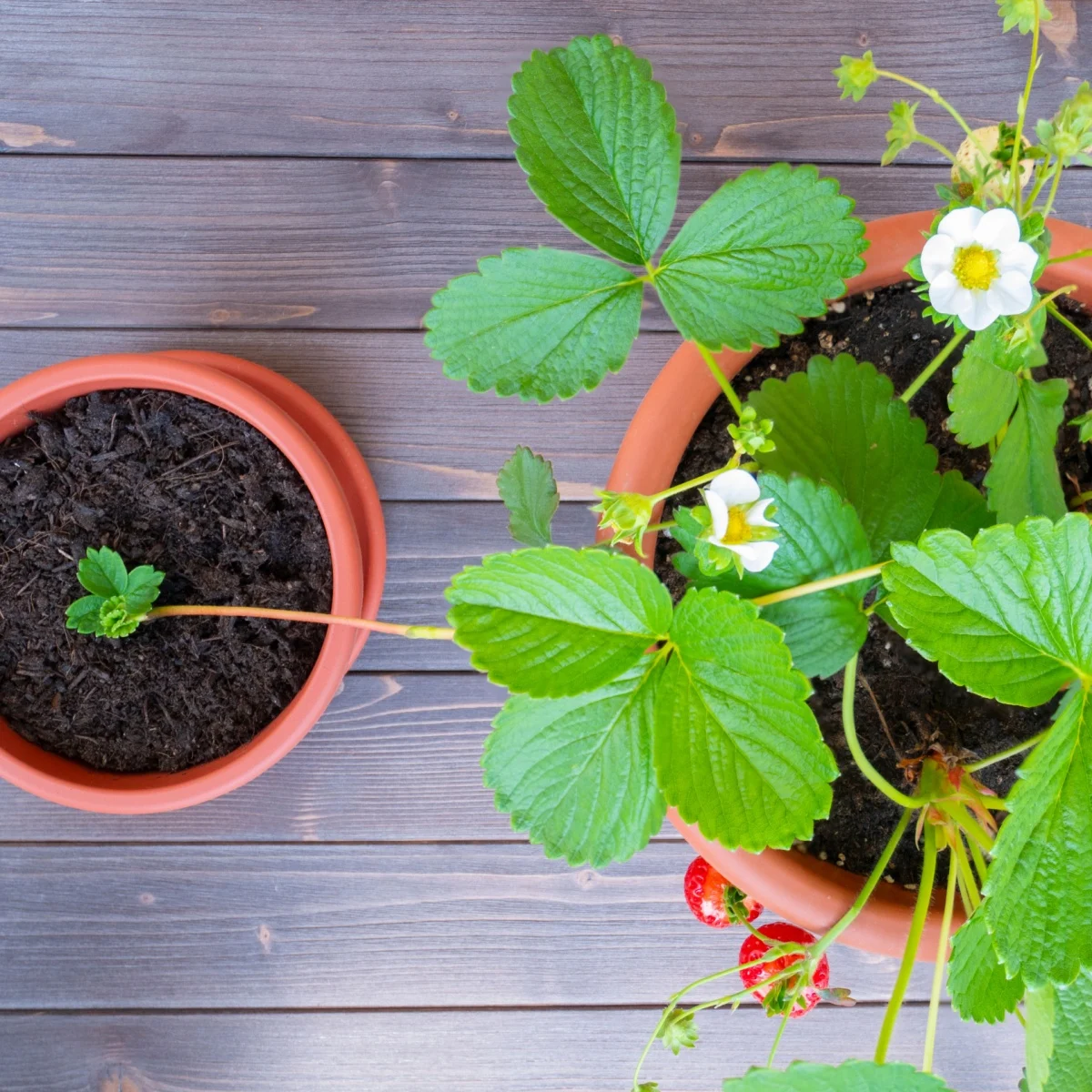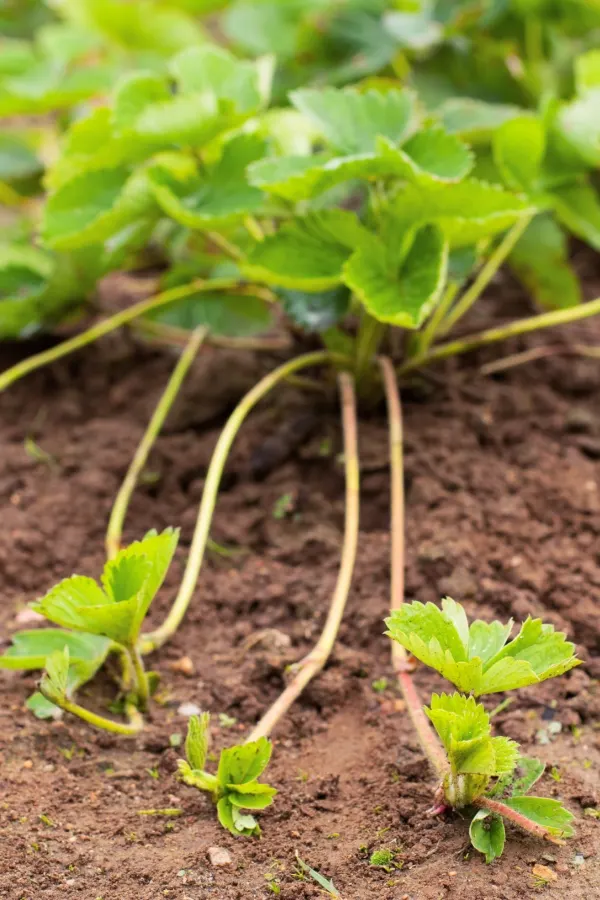Wondering what to do with all those strawberry runners that seem to sprout everywhere from your plants during the summer months?
Not only can strawberry runners be turned into new plants with ease – they can also be perfect for replacing older strawberry plants that are starting to decline – and all without having to worry about spending a fortune on new plants!
While strawberries are considered to be a perennial fruit, they unfortunately start to struggle when it comes to productivity after about 3 to 5 years. It’s at this time that the original plants – also called “Mother plants” – need to be replaced.

But instead of having to purchase brand new plants – you can get new plants right from the same strawberry patch using runners! Not only are the plants free, they more importantly are already conditioned to your soil and climate, which makes them easy to establish quickly.
But even if you don’t need to replace your plants yet – you can also pot up these runners to create new plants for a new patch – or to simply give away to friends, family and neighbors. Here is a look at exactly what runners are, and what to do with them this summer!
What Are Strawberry Runners
Simply put, strawberry runners are offshoots from mature “Mother” plants. These runners grow horizontally along the ground.
The offshoots grow off of a long stem and are essentially “daughter” plants that can turn into mature plants with roots and all. As soon as these runners touch the soil, they start to take root and become established.
Eventually, the stem that connects the mother and daughter plants dries up. Once the plant is fully established, it is now capable of producing strawberry blooms. In addition, it will eventually push out its own runners.

You can use these strawberry runners to make brand new plants. In a way, the mother plants are self-propagating brand-new clone plants for you each and every year. If you don’t want to expand or replace your old plants, simply remove the runners before they get a chance to become established.
Now that you know what strawberry runners are, let’s take a look at how to use these daughter plants to replace old, worn-out mature plants.
How To Turn Strawberry Runners Into New Plants
Types Of Strawberry Plants
Before we get too far into the details, you first need to know that there are two main types of strawberry plants that most home gardeners grow. Both types are capable of producing runners.
The first type is June Bearing strawberries. As you’ve likely guessed, these plants produce strawberries within about a three to four week time frame mainly during the month of June.
June bearing strawberries tend to be larger and are better for those whose goal is canning or preserving. The shorter harvest span allows you to save larger batches of fruit all at once.

Everbearing strawberries, on the other hand, usually have a larger harvest in June and then continue to push out smaller harvests until fall. The berries for everbearing strawberries tend to be smaller, yet they are still full of flavor.
In terms of growing location, since everbearing strawberries are often more compact, they are the better option for growing in containers or pots. Both types grow well in raised beds or traditional in-ground gardens.
Strawberry Types And Their Runners
June bearing strawberry plants tend to send out more runners than everbearing plants. In fact, a single plant is capable of producing over 30 runners in ideal growing conditions. Both wait until after they have completed fruiting before starting this task.
Planting Runners In Pots
One of the most successful ways to grow brand new strawberry plants from runners is to use pots or containers.
This is a great option for those who only need to replace a few plants since the pots can grow directly in the strawberry patch until the runner has taken root. In addition, it’s a great choice for those who wish to move their strawberry patch to a brand new location.

To use this method, fill a 3 to 4-inch container with moist potting soil. Ensure that whatever container you use has sufficient drainage for excess water to drain out of. Product Link: Square Nursery pots 4 Inches
Once you see healthy strawberry runners start to grow, set your container directly underneath the runner. You can pin the runner in place using a small piece of wire or even a hairpin opened up wide.
As soon as the roots touch the soil, they will start to take root. During this time frame, do not remove the stem that connects the runner to the mother plant. However, remove any part of the stem that extends beyond the runner you are trying to root.
After about four to six weeks, give the plant a gentle tug. If there is a slight resistance, the runner has started to become established. You can then cut the stem that connects the mother plant to the runner.
You can now move the container to a different location if desired. After another week or so, you can then plant the new strawberry plant in your desired location.
Planting Strawberry Runners In Rows
Another method of growing strawberries involves growing them in dedicated rows. While it takes some initial planning, it’s easier to keep track of the mother plant’s age and production rate.

This often works best for plants in larger raised beds or in-ground garden spaces since it requires empty space next to the mother plants. The goal is to grow mature plants in one row with a row of empty soil right beside it.
As the mother plants start to produce runners, gently move the runners so they are reaching toward the empty soil. The runners are then able to root and become established in the empty space. Remove any additional runners you don’t wish to become new plants.
You can remove the older, mature plants completely, providing you with empty space for future runners. Essentially, you can replenish your plants every year or two with this simple method.
Digging Up Established Strawberry Runners
If you need to dig up and move runners that have already established, it’s best to do so in late September to early October. This allows the plants time to become re-established in the new location and prepare for fruiting the next season.
Plant these runners just like you would any new transplant. Keep plants watered well and mulch to help protect future fruit. For more on taking care of your strawberry plants year round – be sure to check out our article: How To Grow Strawberries In Your Backyard.
Here’s to creating brand new, healthy, and productive strawberry plants all by using runners!
Simple Garden Life
Follow Our Facebook Page For Even More Great Tips! Simple Garden Life Facebook Page
Simple Garden Life is a website dedicated to keeping gardening fun, simple and enjoyable! We publish two new articles each week along with a new garden podcast episode every two weeks. This article may contain affiliate links.
